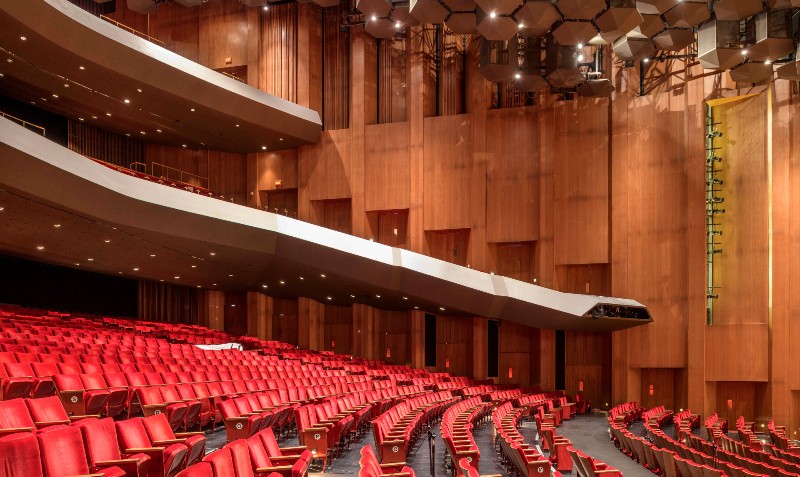Support Us
Houston's independent source of
local news and culture
account
- Welcome,
Insider - Login
- My Account
- My Newsletters
- Contribute
- Contact Us
Jones Hall Renovations: A History of Music and Architectural Technique

Photo by Paul Hester
A four-year project with the goal of better acoustics in Jones Hall.
[
{
"name": "Related Stories / Support Us Combo",
"component": "11591218",
"insertPoint": "4",
"requiredCountToDisplay": "4"
},{
"name": "Air - Billboard - Inline Content",
"component": "11591214",
"insertPoint": "2/3",
"requiredCountToDisplay": "7"
},{
"name": "R1 - Beta - Mobile Only",
"component": "12287027",
"insertPoint": "8",
"requiredCountToDisplay": "8"
},{
"name": "Air - MediumRectangle - Inline Content - Mobile Display Size 2",
"component": "11591215",
"insertPoint": "12",
"requiredCountToDisplay": "12"
},{
"name": "Air - MediumRectangle - Inline Content - Mobile Display Size 2",
"component": "11591215",
"insertPoint": "4th",
"startingPoint": "16",
"requiredCountToDisplay": "12"
}
]
A concert hall is the instrument that all musicians “play.” Whether produced by bowing, blowing, plucking, striking, or phonating, a great hall brings sonic personality to the distinctive timbre of an instrument. And the personality of a hall is dependent on its acoustical properties.
To improve its acoustics and infrastructure, Jones Hall is undergoing a needed update; a project which is being billed, “Overture to the Future.” Begun in 2020, this 50-million-dollar renovation is occurring during the summer months, so regular season performance schedules are not interrupted.
Opening in 1966, this award-winning hall was considered state-of-the-art at the time. And with 800 adjustable acoustic pods in the ceiling, it had the most advanced sound technology of the era. It allowed the acoustical properties of the room to be changed to accommodate the needs of various presenters, including the Symphony, Opera, Ballet, Performing Arts Houston, and other traveling artists.
It is an interesting fact that the highest-rated concert halls of all time were the ones built before 1900. Their secret—rectangular or shoebox shaped, with hard surfaces often quite ornate and with lightly upholstered seating. Often considered the best in the world is the Musikverein in Vienna, Austria. This ornate 1,744 seat hall opened in 1870. "This certainly is the finest hall in the world," said revered conductor Bruno Walter. "It has beauty and power. I had not realized that music could be that beautiful."
So, what happened?
Architects who were designing performance spaces in the 1960s wanted to get away from tradition and began to experiment using advances in science and technology, hoping for something innovative and new. However, over the years these innovations did not quite fulfil expectations and changes had to be made in most halls of this vintage.
Why are these changes necessary and important?
Consider that acoustics for musicians are as essential as water is for swimmers. An acoustically comfortable environment enhances every aspect of performance, allowing musicians to hear their own instrument or voice, and to balance it with others. It blends the instruments rather than blurring them, making each timbre clear and distinct. Players then can adjust expression, dynamics and tuning, resulting in optimal artistry and a more sensory filled listening experience.
Like the unique shape and construction of individual instruments, which gives each a distinct timbre, a great hall has its own sound, and each one is different. In recent years, musicians and acousticians have determined four essential elements needed for an optimal performance hall:
1) Creating adequately intense sound levels (for loud and soft dynamics) that reach both the musician and listener without distortion.
2) Sufficient early sound reflections so you are hearing the sound a few milliseconds after it is played. To achieve this, the sound is being reflected only once or twice from ceilings, walls, and floors.
3) Sound that is evenly distributed throughout the hall so wherever you are seated it is equal in quality.
4) Reverberation characteristics that are appropriate for the music being played.
When the hall joins forces with the orchestra.
The conductor must unify an ensemble of experts in their field—the players of the string, woodwind, brass, and percussion sections and singers. Conductors then must add the unique sound of the concert hall to their interpretive vision. The hall should be at the same quality level as the musicians it serves. It is not merely a hall; it becomes a player in the performance.
Often composers have written their music with a specific acoustic in mind; Handel’s Messiah, for the New Music Hall in Dublin, Bach’s St. Matthew Passion, for St. Thomas Church, Leipzig, Faure’s Requiem, for Paris’s Madeleine Church, and Wagner’s Der Ring des Nibelungen, for his Bayreuth Festspielhaus, specially designed for his operas.
When performing specific styles of music, it is also helpful to know the performance venue and what the composer expected to hear from the music. This informs the musicians of the sound ideal that the composer intended. Music of the 17th and 18th centuries was most often heard in smaller more intimate spaces; many Haydn symphonies, for example, were heard in a 400-seat theater at the Esterhazy estate. In the 19th century and beyond halls increased in size as did orchestras. Mahler’s Symphony No. 8 (Symphony of a Thousand), one of the largest works in the repertoire, was premiered in the 3,000-seat Musik-Festhalle in Munich.
Informed by the performance practices of each era, and knowing the original venues, musicians can make the necessary adjustments to blend, balance, articulate, and phrase the music. All of which must be clearly heard in the performance space. In halls without carefully planned acoustics, the performance will lack clarity. It will become generic and indistinct, making the experience for performer and listener less than optimal.
Iconic British conductor, Sir Adrian Boult famously said: “The ideal hall is obviously that into which you make a not very pleasant sound, and the audience receives something that is quite beautiful.” As Jones Hall continues through these summer upgrades, we can look forward to a revitalized concert experience; one that will give our ears a renewed opportunity to hear music at its most beautiful.

